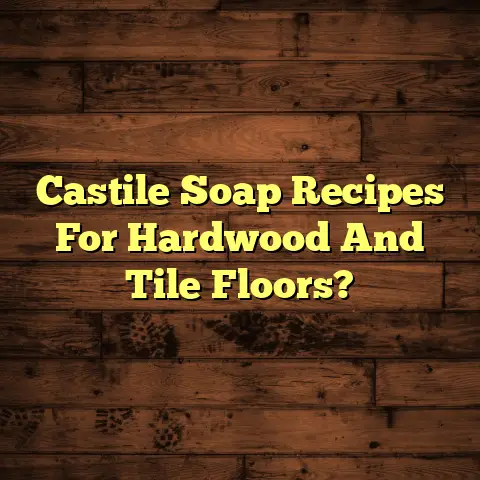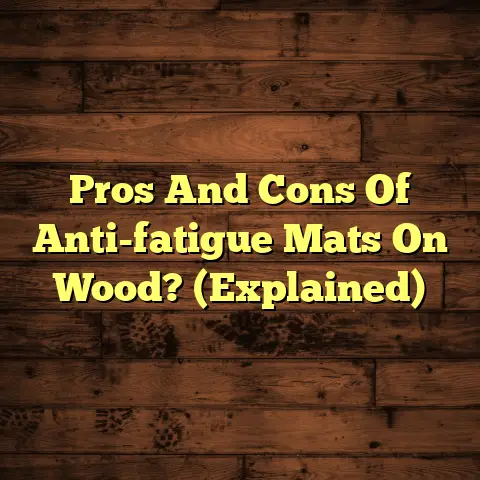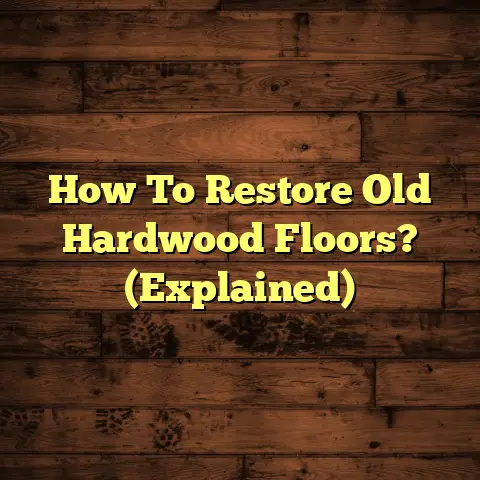Hardwood Floor Differences: Know This (1 Pro Tip!)
It’s not just about looks, although that’s definitely a perk. It’s about picking something that can handle life’s messes, boost your home’s value, and still look amazing years down the line.
The flooring industry has exploded with options, and honestly, it can be overwhelming. That’s why understanding the nitty-gritty of hardwood floors is so important. It’s about making a smart choice that sets your home up for whatever the future throws your way. So, let’s dive in!
Section 1: Understanding Hardwood Flooring
Okay, let’s get down to basics. When we talk about hardwood flooring, we’re mainly talking about two big categories: solid hardwood and engineered hardwood. Think of them as cousins – related, but with very different personalities.
Solid Hardwood
Solid hardwood is exactly what it sounds like: one solid piece of wood from top to bottom. We’re talking classic, old-school flooring here.
Composition: Imagine a tree trunk sliced into planks. That’s essentially what solid hardwood is. It’s made from a single piece of wood, usually ¾ inch thick, but you can find other thicknesses too.
Advantages:
-
Longevity: This stuff can last for generations! I’ve seen solid hardwood floors that are over a century old and still going strong.
-
Refinishing Potential: This is a HUGE plus. Got scratches or want a new look? You can sand down and refinish solid hardwood multiple times. I’m talking 5-7 times, depending on the thickness.
-
Timeless Appeal: There’s just something about real wood that never goes out of style.
Common Types of Wood:
-
Oak: The workhorse of hardwood. It’s durable, readily available, and takes stain well. Plus, it’s relatively affordable. You’ll often hear about red oak and white oak.
-
Maple: A lighter, more modern look. Maple is known for its subtle grain and hardness. It can be a bit trickier to stain evenly, though.
-
Cherry: Rich, warm, and luxurious. Cherry wood darkens over time, adding character. It’s also a softer hardwood, so it might show scratches more easily.
-
Hickory: Super tough and durable, with a rustic grain pattern. Great for high-traffic areas.
Engineered Hardwood
Now, let’s talk about engineered hardwood. This is where things get a bit more technical.
Definition: Engineered hardwood is made up of layers. The top layer is a veneer of real hardwood, while the core is made of plywood or high-density fiberboard (HDF).
Structure: Think of it like a multi-layered cake. You’ve got the top layer (the hardwood veneer), then a core layer (usually plywood or HDF), and sometimes a bottom layer for stability.
Benefits:
-
Stability: This is the big one. Engineered hardwood is much more stable than solid hardwood in varying humidity levels. It’s less likely to warp, cup, or expand.
-
Ease of Installation: Because of its stability, engineered hardwood can be installed in more places than solid hardwood, like basements or over concrete slabs.
-
Cost-Effective: Generally, engineered hardwood is less expensive than solid hardwood.
-
Versatility: The top veneer can be almost any species of wood, so you can get the look you want without the high price tag of solid wood.
Section 2: Key Differences Between Solid and Engineered Hardwood
Alright, let’s break down the real differences between these two types of flooring.
Installation Methods
-
Solid Hardwood: Typically, solid hardwood is installed using a nail-down method. This means nailing the planks directly to a wooden subfloor. You can also glue it down, but that’s less common.
-
Engineered Hardwood: This is where things get interesting. Engineered hardwood can be installed using a few different methods:
- Nail-Down: Similar to solid hardwood.
- Glue-Down: Gluing the planks directly to the subfloor.
- Floating: This is the most common method. The planks click together to form a “floating” floor that isn’t attached to the subfloor.
The installation method can significantly impact the cost and ease of installation. Floating floors, for example, are often DIY-friendly.
Durability and Maintenance
-
Solid Hardwood: Super durable, but it needs some TLC. You’ll want to avoid excessive moisture and use proper cleaning products. Scratches can be sanded out and the floor refinished.
-
Engineered Hardwood: The durability depends on the thickness of the top veneer. A thicker veneer means more durability and the ability to refinish (though usually only once or twice). Engineered hardwood is generally more resistant to moisture than solid hardwood.
Maintenance: Both types of floors need regular sweeping or vacuuming. Avoid harsh chemicals and use a damp mop with a pH-neutral cleaner.
Environmental Impact
-
Solid Hardwood: The environmental impact depends on the sourcing of the wood. Look for wood that’s certified by the Forest Stewardship Council (FSC), which ensures responsible forestry practices.
-
Engineered Hardwood: Engineered hardwood can actually be more sustainable because it uses less of the valuable hardwood. The core is often made from recycled materials. Again, look for FSC certification.
Section 3: Aesthetic Considerations
Let’s talk about looks! After all, your floors are a major design element in your home.
Grain Patterns and Finishes
-
Solid Hardwood: You’re getting the real deal here. The grain patterns are authentic and unique to each plank. You can choose from a variety of finishes, from matte to high-gloss.
-
Engineered Hardwood: The veneer will have the grain pattern of the wood species used. The finishes are similar to solid hardwood, but sometimes the options are more limited.
Popular finishes:
- Matte: A low-sheen finish that hides scratches and dirt well.
- Satin: A slightly higher sheen than matte, providing a subtle shine.
- Semi-Gloss: A more reflective finish that’s easier to clean.
- High-Gloss: A very shiny finish that’s dramatic but shows scratches easily.
Customization Options
-
Solid Hardwood: You can customize solid hardwood with stains, finishes, and textures. Wire-brushing, for example, adds a rustic texture.
-
Engineered Hardwood: The customization options are a bit more limited, but you can still choose from a wide range of colors and finishes.
Trend Analysis
- Wide Planks: Wider planks are super popular right now. They create a more modern and spacious look.
- Light Colors: Light, natural tones are trending, especially for maple and white oak.
- Matte Finishes: Matte finishes are gaining popularity because they’re more forgiving and hide imperfections.
- European Oak: European oak, with its unique grain patterns and subtle color variations, is a high-end trend.
Section 4: Cost Considerations
Let’s get down to the numbers. Flooring is an investment, so it’s important to understand the costs involved.
Initial Costs
-
Solid Hardwood: Typically more expensive than engineered hardwood. Expect to pay anywhere from $8 to $15+ per square foot for the material alone. Installation costs can add another $3 to $8 per square foot.
-
Engineered Hardwood: Generally more affordable, ranging from $4 to $12 per square foot for the material. Installation costs are similar to solid hardwood, but floating installations can be cheaper.
Example: For a 1,000 square foot space:
- Solid Hardwood: Material ($8,000 – $15,000) + Installation ($3,000 – $8,000) = $11,000 – $23,000
- Engineered Hardwood: Material ($4,000 – $12,000)
- Installation ($3,000 – $8,000) = $7,000 – $20,000
Long-Term Value
- Solid Hardwood: Can increase your home’s value, especially if it’s a high-quality wood. The ability to refinish adds to its long-term value.
- Engineered Hardwood: Still adds value to your home, but maybe not as much as solid hardwood. The longevity depends on the thickness of the veneer.
Maintenance Costs: Both types of floors require regular cleaning. Refinishing solid hardwood can cost around $3 to $5 per square foot.
Financing Options
- Home Equity Loans: Use the equity in your home to finance your flooring project.
- Personal Loans: Unsecured loans that can be used for any purpose.
- Credit Cards: Some retailers offer credit cards with special financing options.
- Retailer Promotions: Keep an eye out for sales and promotions from flooring retailers.
Section 5: The One Pro Tip!
Okay, here it is, my one pro tip that can save you a ton of headaches and money in the long run:
Pro Tip: Invest in Quality Over Quantity
I know it’s tempting to go for the cheapest option, but trust me, it’s not worth it. A high-quality hardwood floor, whether it’s solid or engineered, will last longer, look better, and require fewer repairs.
Here’s why:
- Durability: Higher-quality wood is denser and more resistant to scratches and dents.
- Finish: A better finish will protect the wood from wear and tear.
- Installation: Professional installation is key. A poorly installed floor will have problems down the road.
Example: I once had a client who chose a cheap engineered hardwood for their living room. Within a year, the veneer was peeling and the floor looked terrible. They ended up having to replace the entire floor, which cost them twice as much as if they had gone with a higher-quality option in the first place.
How to Invest in Quality:
- Do Your Research: Read reviews and compare different brands and products.
- Talk to a Professional: Get advice from a flooring contractor or retailer.
- Inspect the Wood: Look for dense, consistent grain patterns and a smooth finish.
- Consider the Warranty: A longer warranty is usually a sign of a higher-quality product.
Conclusion
Choosing the right hardwood floor is a big decision, but it’s one that can pay off in the long run. By understanding the differences between solid and engineered hardwood, considering your lifestyle and budget, and investing in quality, you can future-proof your home and create a beautiful and durable space that you’ll love for years to come.
Remember my pro tip: quality over quantity. It’s an investment that will save you money and headaches in the long run. So, take your time, do your research, and choose a floor that you’ll be proud of. Good luck!





